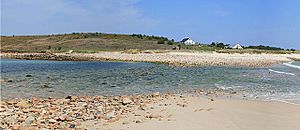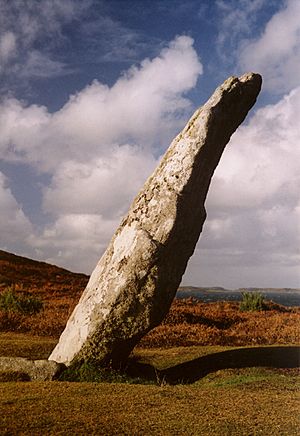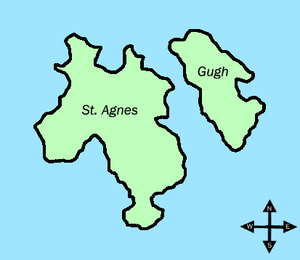Gugh facts for kids
Quick facts for kids Gugh
|
|
|---|---|
 Central Gugh, seen from The Bar |
|
| Population | 3 |
| Civil parish |
|
| Unitary authority | |
| Ceremonial county | |
| Region | |
| Country | England |
| Sovereign state | United Kingdom |
| Post town | ISLES OF SCILLY |
| Postcode district | TR22 |
| Dialling code | 01720 |
| Police | Devon and Cornwall |
| Fire | Isles of Scilly |
| Ambulance | South Western |
| EU Parliament | South West England |
| UK Parliament |
|
Gugh (Cornish: Keow, meaning "hedge banks") is a small island in the Isles of Scilly. It's often thought of as part of St Agnes. This is because a sandy path called "The Bar" connects them at low tide.
Gugh is about 1 kilometer (0.6 miles) long and 0.5 kilometers (0.3 miles) wide. Its highest point is Kittern Hill, which is 34 meters (112 feet) high. The island is made of granite rock, with thin soils on the hills and deeper sandy soils in lower areas.
The island is part of the Isles of Scilly Heritage Coast and an Area of Outstanding Natural Beauty. The Isles of Scilly Wildlife Trust helps manage and protect it. Most of Gugh is covered in wind-swept heath plants or thick bracken and bramble bushes. There's also a small area of coastal grassland near "The Bar."
In 2013, the Isles of Scilly Seabird Recovery Project began. Groups like the RSPB and the Isles of Scilly Wildlife Trust started this project. Their goal was to make St Agnes and Gugh free of brown rats. This helps seabirds, whose numbers dropped by 25% between 1983 and 2006. In 2016, they also started removing an invasive plant called Pittosporum.
Contents
Gugh Island's Ancient History
The first signs of people living on Gugh are from the Bronze Age. You can find groups of entrance graves and cairns. Entrance graves were used for burials or special ceremonies, and cairns are burial mounds. It's hard to know the exact dates because the soil has destroyed most old items. However, some pottery suggests they are from the late Neolithic or early Bronze Age.
On Kittern Hill, there are five entrance graves. One of these, called Obadiah's Barrow, was dug up in 1901. Inside, people found bones that were not burned. There are also fourteen cairns linked by ancient field walls.
The Old Man of Gugh is a tall standing stone, about 2.7 meters (9 feet) high. It's the only standing stone on Scilly that has been excavated, but no special items were found around it. In the southern part of Gugh, there are nineteen more cairns and an old field system. Two more entrance graves are also there. During the English Civil War, a military battery was built over one of these graves. Its chamber was used to store ammunition. Gugh is now a Scheduled Monument, which means it's a protected historical site.
Life on Gugh Through the Centuries
For many years, Gugh was not lived on by people. Residents from St Agnes used it to graze their cattle. People also used to burn seaweed in pits to make a chemical called sodium carbonate. This was used for making glass. This practice started in 1684 and continued until 1835. However, it stopped because better ways to make sodium carbonate were invented.
In the 1920s, a man named William Hamlet Cooper leased the island. He was a retired surveyor. He built the two houses you can see on Gugh today and started a farm. He lived there with his housekeeper. Cooper tried to control large gulls by shooting them and destroying their eggs. He wrote in a newspaper that gulls attacked his cattle and sheep, even causing a valuable ram to die.
When Cooper died in 1932, his animals and crops were sold. This included chickens, cows, horses, pigs, potatoes, and other farm goods. He also grew narcissus flowers for their bulbs.
In September 1933, a fire burned on Gugh for a week. The whole island seemed to be on fire. Workers from Major Dorrien-Smith helped put out the fire. The only people living on the island at the time were Mr. and Mrs. Theo Bond. Their farmhouse and farm buildings were saved. The Bonds had spent their honeymoon on Gugh and decided to live there and continue growing flowers.
Gugh's Natural Environment
Gugh was named a Site of Special Scientific Interest (SSSI) in 1976. This means it's a special place for nature. The SSSI covers about 36.6 hectares (90.4 acres). In 2010, most of it was considered "unfavourable recovering." This means it's getting better but still has some problems.
One problem is too much bramble and Pittosporum plants. Also, the heath on Kittern Hill is not as interesting as other parts of the island. This might be because of a fire in 1972. The Pittosporum needs to be controlled, and the island needs animals to graze there. This would help the land return to a healthier state.
Plants of Gugh Island
Much of Gugh's plant life is dry, wind-swept heath or thick gorse and bracken. The main plants on the heath are heather, bell heather, and western gorse. Near "The Bar," you can find dune grassland and coastal grassland. Here, plants like western clover, sea holly, and sea spurge grow.
The middle part of the island, where the farm used to be, has unusual plants. You can find balm-leaved figwort, which is rare elsewhere on the island. There's also a yellow rose that was planted there. Another plant, Argentine dock, grows near an old sand pit. Before 1933, the fields near the houses were fertilized with a special manure. Now, you can find plants like viper's-bugloss and common melilot there. These are thought to be weeds brought in by farming.
In 1972, a fire on Kittern Hill burned deep into the soil. You can still see bleached stones and burnt gorse stems. The plants there have not fully recovered. In the south of the island, you can find the rare orange bird's-foot plant and rare lichens like Lobaria pulmonaria.
Rare Plants of Gugh
- Shore dock (Rumex rupestris) was found here in 1893 but is now gone.
- Small adder's-tongue (Ophioglossum azoricum) hasn't been seen since the mid-1980s.
- Four-leaved allseed (Polycarpon tetraphyllum) was recorded in 1939 and 1940.
Animals of Gugh Island
In 1924, a scientist found a new type of shrew on Gugh. It was identified as the lesser white-toothed shrew, now known as the "Scilly shrew." Other mammals on Gugh include wild cats, rabbits, and possibly house mice.
Rabbits are currently the only animals that graze on the island. In the 1960s, a disease called myxomatosis greatly reduced the rabbit population. This led to more scrub and bramble growing on parts of the island. Natural England would like to bring grazing animals back to Gugh. This would help control the scrub and thick grass.
In the southern part of Gugh, many lesser black-backed gulls and herring gulls nest. A few greater black-backed gulls also breed there. However, storm petrels and kittiwakes no longer breed on Gugh.
To help seabirds, a study was done to see if rats could be removed from the Isles of Scilly. The study found that about 3,300 brown rats lived on St Agnes and Gugh. Rats eat eggs and kill chicks of birds that nest on the ground. They also eat Scilly shrews. Where rats were controlled, shrew numbers were higher. This showed that removing rats would greatly benefit seabirds and shrews.
After the rat removal program, 12 Manx shearwater chicks successfully left their nests on Gugh and St Agnes in September 2014.
Rare and Visiting Birds
- A white-tailed eagle with a huge wingspan was shot on Gugh in November 1909.
- Another white-tailed eagle was seen on the Isles of Scilly in 1947. It was thought to rest on Gugh and was seen eating a shag.
- A rare two–barred greenish warbler was found on Gugh in October 1987. This was the first time this bird had been seen in Britain and Ireland.
Insects of Gugh
Some insects found on Gugh include:
- Cocksfoot moth (Glyphipterix simpliciella)
- Nothris congressariella, whose caterpillars eat balm-leaved figwort
- Epagoge grotiana
- Scoparia subfusca
- Common carpet moth (Epirrhoe alternata)
- Purple bar moth (Cosmorhoe ocellata)
Habitat Restoration Efforts
The Isles of Scilly Seabird Recovery Project started in 2013. Its main goal is to keep St Agnes and Gugh free of brown rats (Rattus norvegicus). Rats eat the eggs and kill the chicks of seabirds that nest in burrows or on the ground.
A team of volunteers began removing rats in October 2013. Since December 2013, there have been no signs of rats on St Agnes and Gugh.
The rangers from the Isles of Scilly Wildlife Trust also started removing the invasive Pittosporum plant in 2016. By 2019, they had cleared 1.2 hectares (about 3 acres) from seabird nesting areas and historical sites. They also worked to create different heights of vegetation in the grasslands. This helps rare plants like orange bird's-foot and clovers, which need short grass, and other plants that prefer longer grass.
See also
 In Spanish: Gugh para niños
In Spanish: Gugh para niños




